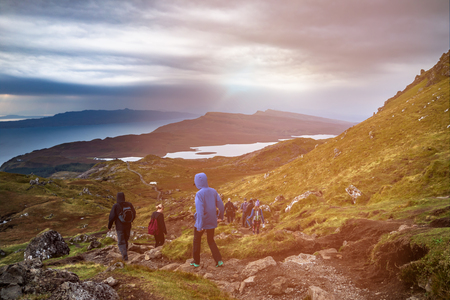Introduction to Year-Round Hiking in Scotland
The Scottish Highlands are famed for their breathtaking beauty and diverse terrain, making them a dream destination for walkers throughout the year. From the rolling heather moors and rugged mountain peaks to serene lochs and ancient woodlands, each season transforms this dramatic landscape in its own distinct way. Spring brings a carpet of wildflowers and fresh greenery, while summer offers long daylight hours and vibrant wildlife. Autumn paints the hillsides with fiery hues and crisp air, and winter covers the peaks in a magical dusting of snow. No matter the time of year, the Highlands present unique opportunities for keen hikers seeking both challenge and tranquillity. Whether you’re drawn to gentle rambles or ambitious climbs, exploring the Highlands across all seasons promises unforgettable experiences rooted in Scotland’s rich natural heritage.
Spring Excursions: Wildflowers and Emerging Wildlife
As winter’s chill recedes, the Scottish Highlands undergo a vivid transformation. Spring is arguably one of the most enchanting seasons for hiking in Scotland, offering a unique blend of blossoming landscapes, lively wildlife activity, and crisp, invigorating air. The hillsides burst into colour with carpets of wildflowers, while native creatures stir from their winter slumber—creating an ever-changing tableau for ramblers and nature enthusiasts alike.
Best Spring Routes to Explore
Scotland’s diverse terrain offers a selection of springtime routes that showcase both floral displays and wildlife sightings. Here are some top recommendations:
| Route | Region | Highlights |
|---|---|---|
| The West Highland Way (Milngavie to Fort William) | Central Highlands | Bluebells and primroses, red deer sightings, varied landscapes |
| Cairngorms National Park Circulars | Northeast Highlands | Pine forests with wood anemones, capercaillie and mountain hare |
| Glen Affric Trails | Northwest Highlands | Birch woods carpeted with violets, otters by lochs, golden eagles overhead |
| Ben Lomond Path | Loch Lomond & The Trossachs | Heather moorlands, spring lambs, panoramic views over Loch Lomond |
Breathtaking Foliage and Native Animals
The highland glens and lower slopes come alive with blooming heather, bluebells, gorse, and wild garlic. Early mornings are especially rewarding as roe deer graze quietly at the woodland edge and birds such as ospreys return to nest. Keep your eyes peeled for elusive pine martens darting through the undergrowth or listen for the distinctive drumming of woodpeckers in ancient Caledonian pinewoods.
Essential Gear for Spring Hiking in Scotland
The unpredictability of Scottish weather is legendary—spring can bring sunshine one minute and hail the next. To ensure comfort and safety on your hike:
- Layered Clothing: Opt for breathable base layers, insulating mid-layers, and a waterproof outer shell.
- Waterproof Footwear: Paths may be muddy or slick with spring meltwater.
- Packed Essentials: A map and compass (mobile signal is unreliable in remote areas), first aid kit, snacks, water bottle, and insect repellent for early midges.
- Weather Awareness: Always check the latest Met Office forecast before setting out.
A Note on Local Etiquette & Conservation
Please stick to marked paths to protect delicate wildflower habitats and minimise disturbance to nesting wildlife. The Scottish Outdoor Access Code encourages hikers to leave no trace—carry out your litter and respect both livestock and farm gates along your journey. By embracing this ethos, you’ll help preserve the natural beauty that makes spring hiking in Scotland so special.

3. Summer Adventures: Long Days and Highland Festivals
Summer in the Scottish Highlands is a truly special time for hikers, with daylight lingering well into the evening and temperatures rising to a comfortable level for outdoor exploration. The extended hours of sunlight—often up to 18 hours in June—mean you can plan ambitious routes or take your time enjoying the stunning vistas without rushing back before dark. Popular trails such as the West Highland Way, Ben Nevis, and the Cairngorms offer spectacular scenery at its vibrant best, from wildflower meadows to sparkling lochs.
Beyond the hiking itself, summer brings a burst of local life and culture with traditional Highland festivals. Events like the Inverness Highland Games or smaller gatherings in rural villages showcase Scottish music, dancing, and athletic competitions. These festivals are fantastic opportunities to experience authentic community spirit and sample local fare after a long day on the trail.
However, summer also signals the arrival of midges—tiny biting insects notorious throughout Scotland. It’s wise to pack effective insect repellent and consider wearing long sleeves and trousers when pausing during your walk, especially near water or at dusk. With proper preparation, the rewards of hiking in the Highlands during summer far outweigh this minor inconvenience, offering unforgettable adventures surrounded by natural beauty and lively Scottish traditions.
4. Autumn Walks: Dramatic Colours and Tranquil Trails
As the Highlands slip into autumn, Scotland transforms into a landscape of copper, gold, and scarlet. The woodlands around Loch Ness, Glen Affric, and Perthshire become a living tapestry, providing hikers with some of the most breathtaking scenes of the year. Autumn is not only about vibrant foliage—it also means quieter trails and a slower pace, allowing for a more immersive connection to nature.
Advice for Enjoying Scotland’s Autumnal Scenery
With the summer crowds having thinned, autumn is prime time for those who prefer solitude on their rambles. Early morning or late afternoon hikes can be especially rewarding, as low sunlight intensifies the colours and mists linger across glens and lochs. Consider bringing waterproof boots and layers; autumn in Scotland can be unpredictable, with both crisp days and sudden showers.
Best Highland Locations for Autumn Walks
| Location | Highlights | Recommended Routes |
|---|---|---|
| Glen Affric | Ancient Caledonian pinewoods, mirrored lochs, rich autumn colour | Dog Falls Trail, Affric Kintail Way |
| Perthshire (“Big Tree Country”) | Dramatic beech and oak forests, riverside walks | The Hermitage, Faskally Wood (Enchanted Forest) |
| Cairngorms National Park | Purple heather moorland fading to ochre, wildlife spotting (red deer rutting season) | Loch an Eilein Circuit, Ryvoan Pass |
| Trossachs National Park | Misty lochs, golden birch trees | Ben A’an summit trail, Loch Katrine shoreline walk |
Harvest-Time Culture in the Highlands
Autumn is also when Highland communities come together to celebrate the end of harvest. Local farmers’ markets are brimming with seasonal produce—think apples, root vegetables, wild mushrooms, and venison. Many villages host food festivals or ceilidhs (traditional dances), which are excellent opportunities to experience Scottish hospitality. Don’t miss out on hearty dishes like cullen skink or game stew at local inns after a day’s hike.
Tips for a Memorable Autumn Hike in Scotland:
- Dress in layers: Weather can change quickly—waterproofs are essential.
- Respect deer stalking season: Check local signage or ask rangers about safe routes.
- Book accommodation early: Some rural B&Bs fill up fast during autumn festivals.
- Savour local flavours: Try freshly-baked oatcakes or locally-sourced jams.
- Bring a camera: Low light makes for stunning photographs—but always enjoy the moment first.
This season offers not just visual splendour but cultural richness—a perfect time to slow down and appreciate both the land and its people while hiking through the ever-changing Highlands.
5. Winter Rambles: Snowy Peaks and Cosy Bothies
Scotland’s Highlands in winter transform into a dramatic landscape of snow-dusted munros, frosted glens, and icy lochs. For those seeking adventure, winter rambling offers a distinctive experience, but it does require extra preparation and respect for the elements.
Guidance on Safe Winter Walking
Before setting out, check weather forecasts from the Met Office and avalanche reports from Scottish Mountain Rescue. Daylight hours are short; plan your walks to finish well before dark. Equip yourself with waterproof boots, gaiters, insulated layers, and – crucially – an ice axe and crampons for higher ground. Navigation skills are essential as snow can obscure paths and landmarks. Inform someone of your intended route and expected return time.
Potential Routes for Snowshoeing
The Cairngorms National Park is a prime destination for snowshoeing, with gentle trails near Glenmore or more challenging ascents towards Cairn Gorm itself. Glen Nevis offers rewarding circuits beneath Ben Nevis’s north face, while the Great Glen Way provides lower-level options if conditions at altitude are severe. Always assess avalanche risk before venturing onto open slopes.
Mountain Challenges in the Highlands
Winter hiking in the Highlands is not to be underestimated. Weather can shift rapidly, bringing blizzards or whiteouts. Fitness and experience matter: even modest hills like Schiehallion or Meall nan Tarmachan can become serious undertakings in deep snow. Consider joining a guided group or hiring a qualified mountain leader if you’re new to winter walking.
The Warm Tradition of Bothy Stays
No winter adventure in Scotland would be complete without a night in a bothy – those rustic stone shelters scattered across remote glens and hillsides. Bothies offer welcome refuge from biting winds and driving sleet, often with nothing more than a fireplace and wooden bunks. Bring your own supplies (including firewood), leave no trace, and share stories with fellow ramblers over a mug of tea or dram of whisky. It’s an authentic Highland tradition that turns even the coldest hike into a heartening memory.
6. Scottish Hillwalking Etiquette and Safety Essentials
Understanding Your Right of Access
Scotland’s unique access laws offer hillwalkers exceptional freedom to explore its wild landscapes year-round. Under the Land Reform (Scotland) Act 2003, you have the right to walk almost anywhere, provided you do so responsibly. This is often called the “right to roam”. Always follow the Scottish Outdoor Access Code: be considerate of landowners, respect privacy around homes and gardens, and close gates behind you. Remember, this right comes with responsibilities—use it wisely.
The ‘Leave No Trace’ Principle
Scottish hillwalking culture places a high value on preserving natural beauty for future generations. The ‘leave no trace’ ethos means you should take all your litter home, avoid disturbing plants or wildlife, and stick to existing paths where possible to prevent erosion. Wild camping is permitted in much of Scotland, but pitch your tent discreetly, keep group sizes small, and minimise your impact on the landscape.
Essential Safety Practices
Emergency Contacts and Preparation
The Highlands can be remote and weather conditions change rapidly in every season. Always check forecasts before you set out. Carry a map and compass—and know how to use them—as mobile signal can be unreliable. Inform someone about your planned route and expected return time. For emergencies, dial 999 or 112 and ask for Mountain Rescue; services are highly trained and familiar with local terrain.
Respecting Farmland and Wildlife All Year
Many Highland routes cross farmland or pass near livestock. Keep dogs under close control, especially during lambing season (spring) or when birds are nesting (April to July). Avoid disturbing wildlife at any time of year; observe deer, birds, and other animals from a respectful distance. If crossing fields, stick to the edges rather than trampling crops or grass.
Cultural Considerations for Walkers
Scottish walkers often greet each other with a friendly nod or “hello” on the trail—a small gesture that reflects the welcoming spirit of the outdoors community. Be prepared for rapidly shifting weather by carrying suitable clothing year-round; sudden mists or showers are part of the authentic Highlands experience. By following these cultural practices and safety essentials, you’ll contribute positively to Scotland’s rich tradition of respectful hillwalking in every season.
7. Resources and Local Support for Hikers
Exploring the Highlands year-round is as much about preparation as it is about adventure. Fortunately, Scotland offers a robust network of resources and local support to ensure your hiking experience is both safe and rewarding.
Walking Clubs and Local Groups
Joining a local walking club is an excellent way to meet like-minded hikers, access insider knowledge, and participate in guided walks. Organisations such as The Ramblers Scotland and Mountaineering Scotland are active throughout the Highlands, offering regular group hikes suited to all abilities and seasons. Many smaller towns also have community walking groups that welcome visitors for day excursions or social rambles.
National Park Visitor Centres
The Highlands are home to two major national parks: Cairngorms National Park and Loch Lomond & The Trossachs National Park. Each park boasts well-equipped visitor centres providing up-to-date trail information, weather advice, maps, and guidance on local flora and fauna. Staff at these centres are invaluable sources of current path conditions and can suggest routes tailored to seasonal highlights.
Weather Resources
The Highland climate can change rapidly, so reliable weather updates are essential. The Met Office Mountain Weather Service gives detailed forecasts specific to Scottish mountain regions. For real-time updates and avalanche warnings during winter months, check the Scottish Avalanche Information Service (SAIS). It’s wise to consult these resources before every hike, regardless of the time of year.
Kit Hire and Outdoor Shops
If you need to upgrade your gear or hire equipment for your walk, the Highlands are dotted with reputable outdoor shops. In key towns such as Aviemore, Fort William, and Inverness, stores like Tiso Outdoor Experience, Cotswold Outdoor, and independent retailers offer everything from waterproofs to crampons. Many provide kit hire—ideal if you’re travelling light or want to test specialist equipment before committing to a purchase.
Top Tips for Using Local Resources:
- Always check in with visitor centres for the latest trail advice.
- Consider joining a guided walk when trying out new areas or tackling challenging routes.
- Support local businesses by hiring or buying gear in the Highlands—staff often have excellent route recommendations.
Your Highland Adventure Awaits
No matter the season, these resources make it easier—and safer—to experience Scotland’s wild beauty. Take advantage of local expertise, stay prepared with the right kit, and embrace the unique character of each season as you explore the Highlands year-round.


